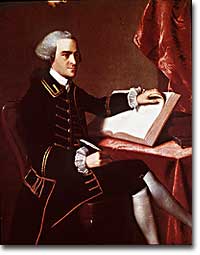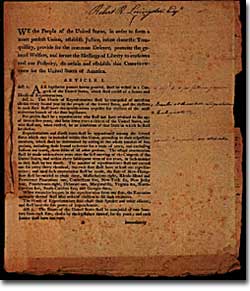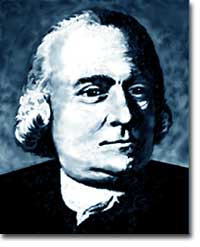16c. The Ratification Process: State by State

The man behind the signature: This portrait of John Hancock was painted by John Singleton Copley.
The ratification process started when the Congress turned the Constitution over to the state legislatures for consideration through specially elected state conventions of the people. Five state conventions voted to approve the Constitution almost immediately (December 1787 to January 1788) and in all of them the vote was unanimous (Delaware, New Jersey, Georgia) or lopsided (Pennsylvania, Connecticut). Clearly, the well-organized Federalists began the contest in strong shape as they rapidly secured five of the nine states needed to make the Constitution law. The Constitution seemed to have easy, broad, and popular support.
However, a closer look at who ratified the Constitution in these early states and how it was done indicates that the contest was much closer than might appear at first glance. Four of the five states to first ratify were small states that stood to benefit from a strong national government that could restrain abuses by their larger neighbors.

This copy of the Constitution was used by delegates to the New York ratification convention.
The process in Pennsylvania, the one large early ratifier, was nothing less than corrupt. The Pennsylvania state assembly was about to have its term come to an end, and had begun to consider calling a special convention on the Constitution, even before Congress had forwarded it to the states. Antifederalists in the state assembly tried to block this move by refusing to attend the last two days of the session, since without them there would not be enough members present for the state legislature to make a binding legal decision. As a result extraordinarily coercive measures were taken to force Antifederalists to attend. Antifederalists were found at their boarding house and then dragged through the streets of Philadelphia and deposited in the Pennsylvania State House with the doors locked behind them. The presence of these Antifederalists against their will, created the required number of members to allow a special convention to be called in the state, which eventually voted 46 to 23 to accept the Constitution.
The first real test of the Constitution in an influential state with both sides prepared for the contest came in Massachusetts in January 1788. Here influential older Patriots like Governor John Hancock and Sam Adams led the Antifederalists. Further, the rural western part of the state, where Shays' Rebellion had occurred the previous year, was an Antifederalist stronghold. A bitterly divided month-long debate ensued that ended with a close vote (187-168) in favor of the Constitution. Crucial to this narrow victory was the strong support of artisans who favored the new commercial powers of the proposed central government that might raise tariffs (taxes) on cheap British imports that threatened their livelihood. The Federalists' narrow victory in Massachusetts rested on a cross-class alliance between elite nationalists and urban workingmen.

A revolutionary leader in Massachusetts, Samuel Adams founded Bowdoin College when he was governor of Massachusetts. At the time, Maine (where Bowdoin College is located) was part of Massachusetts.
The Massachusetts vote also included an innovation with broad significance. John Hancock who shifted his initial opposition to the Constitution led the move toward ratification. Satisfied that certain amendments protecting individual rights were going to be considered by the first new Congress that would meet should the Constitution become law. This compromise helped carry the narrow victory in Massachusetts and was adopted by every subsequent state convention to ratify (except Maryland).
By the spring conventions in the required nine states had ratified, and the Constitution could become law. But with powerful, populous, and highly divided Virginia and New York yet to vote, the legitimacy of the new national system had not yet been fully resolved.






